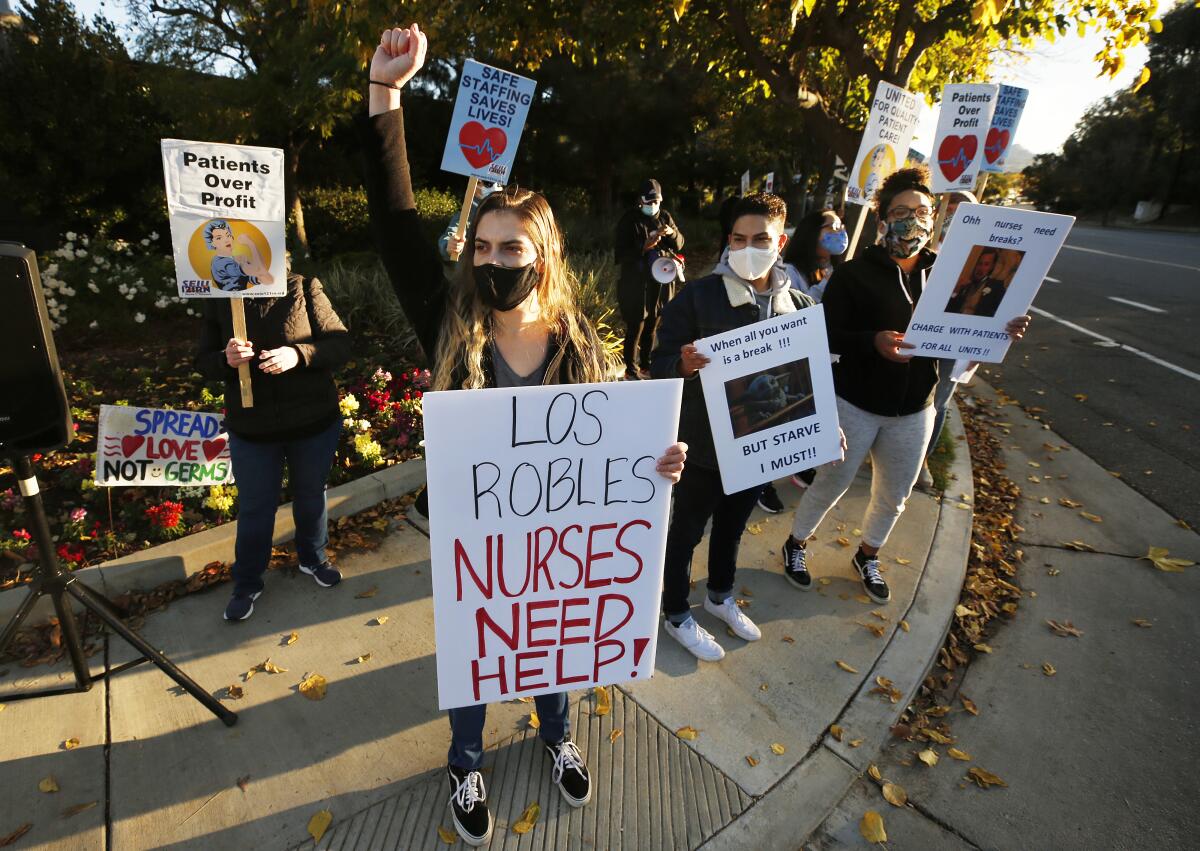California urges weekly COVID-19 testing for hospital workers

- Share via
After months of rallies, protests and pleas by healthcare workers for better coronavirus protection, California has unveiled some of the nation’s strongest COVID-19 testing guidelines for hospital personnel, many of whom are bracing for a post-Thanksgiving virus surge.
The guidelines, announced in an all-facilities letter from the California Department of Public Health, stipulate that all workers at general acute-care hospitals — the kind most people go to for short-term care — be tested weekly for the coronavirus. Tests must also be administered to all newly admitted patients.
“It’s a huge victory that will save lives,” said Sal Rosselli, president of the National Union of Healthcare Workers, which represents more than 15,000 healthcare workers in California and helped lobby for the change.
Gov. Gavin Newsom has announced a stay-at-home order affecting most of California.
Before the policy update, the state had no formal testing requirements for healthcare workers, Rosselli said. The introduction of weekly testing, which benefits both patients and workers, was long overdue.
“Sports players and their teams are tested every day to keep them safe,” Rosselli said, “and elite colleges are testing their entire student bodies and faculties every week to minimize COVID infection. But hospital workers who take care of people with COVID couldn’t get tested.”
Under the guidelines outlined in the letter, dated Nov. 25, hospitals will have until Dec. 7 to submit a formal, facility-wide testing plan to their local licensing authority. Weekly test procedures for all healthcare workers must be in place by Dec. 14.
Hospitals must also outline policies and procedures for explaining and tracking results, and for using those results to implement greater infection control measures.
The guidelines are similar to those authorized for California nursing homes earlier this year, which contributed to a decrease in coronavirus cases and deaths at those facilities, Rosselli said.
They arrive as California is experiencing a record number of hospitalizations: There were 7,415 COVID-19 patients in the state’s hospitals on Saturday, surpassing the previous high of 7,170 set in July.
In a media briefing Monday, Gov. Gavin Newsom said projections for hospitalization numbers are grim.
“Without any additional interventions, change of behavior or fundamental shifts in the way we are conducting ourselves as individuals in this state, we could see an increase in hospitalizations two to three times greater than the current census in just one calendar month,” he said.
Fifty-nine percent of California’s hospital beds are in use, Newsom said, and projections indicate that number could climb to 78% by Christmas Eve.
“We’re not just looking at positivity rates, we’re not just looking at case rates,” he said. “We are now looking in real time at hospitalizations and ICU capacity.”
In its guidelines, the Department of Public Health said healthcare personnel in areas with elevated community transmission — a list that now includes almost every county in California — are at a higher risk because they are exposed to COVID-19 both at work and at home.
Per the new guidelines, healthcare personnel include all paid and unpaid workers who have “the potential for direct or indirect exposure to patients,” and account for doctors and nurses as well as students, volunteers, pharmacists, laundry and facilities workers, administrative employees and others.
Routine screening can aid in early identification of infected personnel, reduce the risk of transmission to other healthcare workers and patients, and prevent hospital outbreaks, the department said.
“Every day, we hear how respected the nursing workforce is, and how they’re the heartbeat of the hospital,” said Stephanie Roberson, director of government relations at the California Nurses Assn.
“But all that pomp and circumstance doesn’t amount to anything when a nurse goes into a facility and is willing to take care of their patients, and is willing to take every measure and precaution available to continue to work in these dire circumstances,” she said. “They just want to be protected.”
The California Nurses Assn. represents more than 100,000 nurses statewide and has been outspoken about the need for better safety protections for nurses, healthcare workers and patients on the front lines of the pandemic.
In August, they organized a rally about the issue in Orange County.
“We applaud California for being a leader in requiring this type of testing program because it is desperately needed to fight this virus,” association president and Bay Area nurse Zenei Triunfo-Cortez said in a statement Monday about the new guidelines.
“There are simply too many asymptomatic people with COVID,” Triunfo-Cortez said, “and without robust testing, our hospitals will remain centers for spreading the disease instead of centers of healing as they should be.”
More to Read
Sign up for Essential California
The most important California stories and recommendations in your inbox every morning.
You may occasionally receive promotional content from the Los Angeles Times.











